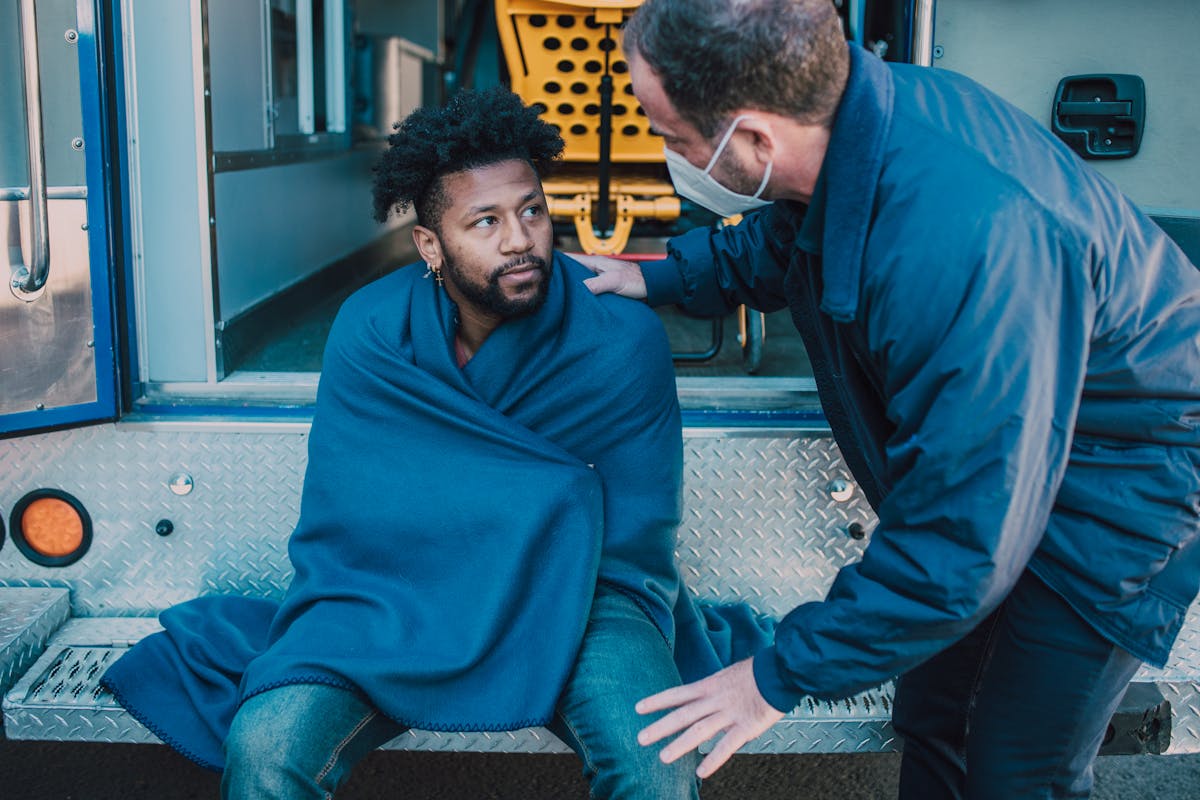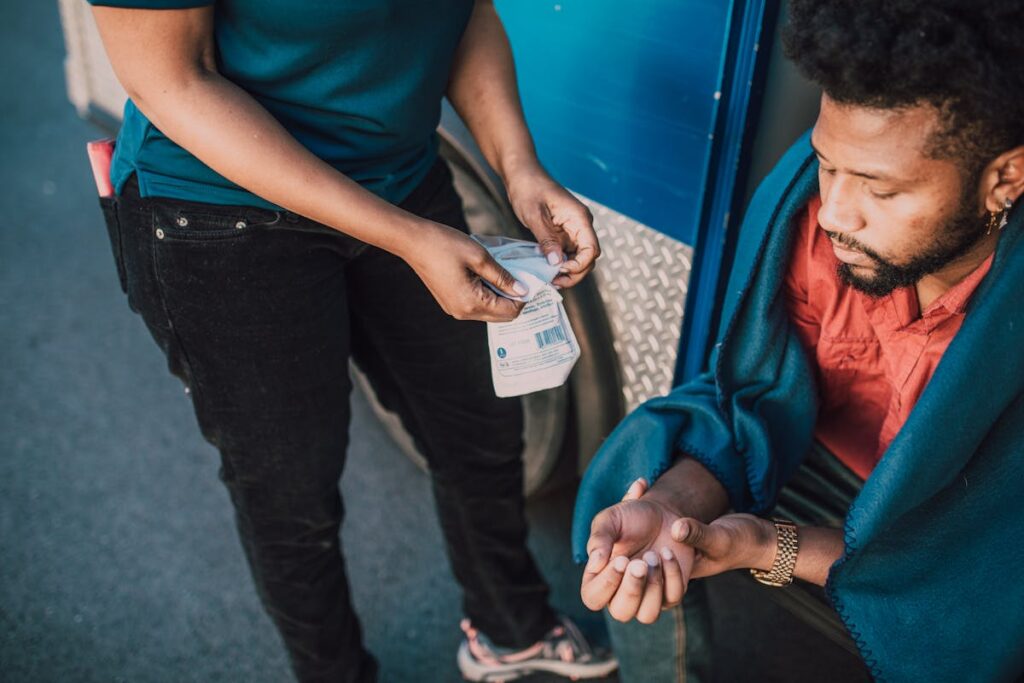In the aftermath of a hit and run accident, immediate action is vital to guarantee safety and facilitate a successful resolution. The priority should be moving to a secure location and evaluating for injuries, followed by contacting emergency services. Documenting the scene meticulously, gathering witness accounts, and notifying authorities are critical steps in building a strong case. How you proceed next could greatly impact both your recovery and the justice process.
Ensure Safety and Check for Injuries
In the aftermath of a hit-and-run accident, the paramount concern should be ensuring the safety of all individuals involved. Implementing immediate safety measures is vital. First, the affected vehicle should be moved to a safe location, such as the shoulder of the road, if possible. This action minimizes further risks. Next, passengers and drivers must be instructed to remain calm and avoid abrupt movements, which could exacerbate potential injuries. A thorough injury assessment should be conducted promptly. Checking for visible injuries, signs of shock, or unconsciousness is essential. Even minor discomfort should be noted, as latent injuries can develop. Prioritizing safety measures and conducting a careful injury assessment sets the foundation for effective response and recovery in such unpredictable situations.
Call Emergency Services
Immediately contacting emergency services after a hit and run accident is essential for ensuring timely assistance and initiating an official report. Providing accurate details, including the location, time, and any vehicle descriptions, can greatly aid law enforcement in their investigation. This decisive action not only facilitates medical aid if needed but also strengthens the legal groundwork for future proceedings.
Report Incident Immediately
When faced with the aftermath of a hit and run accident, one of the most vital steps to take is reporting the incident to emergency services without delay. Engaging in this reporting process promptly is not only a vital step towards guaranteeing personal safety but also fulfills one’s legal obligations. By contacting emergency services immediately, individuals initiate a formal record of the incident, which can be pivotal for subsequent legal and insurance procedures. This decisive action can facilitate the apprehension of the responsible party and potentially mitigate further legal complications. Furthermore, timely reporting guarantees that any injuries are addressed quickly, safeguarding the health and wellbeing of those involved. Ultimately, such promptness reinforces accountability and adherence to legal standards, essential in such distressing situations.
Provide Accurate Details
How can one guarantee that the response to a hit and run accident is as effective as possible? Providing accurate descriptions to emergency services is essential. The importance of detail cannot be overstated. When calling emergency services, one must deliver precise information about the accident location, vehicle descriptions, and any visible injuries. Capturing details such as the make, model, color, and license plate of the fleeing vehicle can greatly aid law enforcement. Additionally, noting the time of the incident and environmental conditions, like weather and lighting, enhances the report’s usefulness. Witness accounts, if available, should be relayed to emergency personnel. These detailed descriptions create a foundation for authorities to act swiftly and increase the chances of apprehending the responsible party.
Gather Information From the Scene
In the aftermath of a hit and run accident, why is it vital to gather information from the scene meticulously? A thorough scene assessment is essential in piecing together the unfolding of events. By meticulously documenting the environment, individuals can aid in evidence collection that may prove pivotal in legal proceedings or insurance claims. Recording pertinent details such as the time, location, and any identifying marks left by the fleeing vehicle enriches the pool of actionable data. Photographs of the scene, including damages and road conditions, bolster the evidentiary foundation. These efforts guarantee that nothing is overlooked, thereby strengthening the pursuit of justice. A diligent approach to gathering information not only aids authorities in their investigation but also supports the victim’s path to resolution.
Look for Witnesses
After meticulously gathering information from the scene, identifying witnesses becomes a vital step in the aftermath of a hit and run accident. Witnesses can provide essential insights that may not be evident to the victims themselves. Their accounts can bolster claims and guarantee justice is served. However, it is important to assess witness credibility accurately. This involves evaluating their proximity to the incident, their vantage point, and the consistency of their recollections. Persuasively securing thorough witness statements can greatly aid an investigation. These statements should capture precise details of the event, the vehicle involved, and any potential driver identification. A credible witness can often be the linchpin in reconstructing the event accurately, thereby aiding authorities in their pursuit of the perpetrator.
Take Photos and Videos
Capturing the scene with photographs and videos is an indispensable step in documenting a hit and run accident. Employing effective photography techniques guarantees critical details are preserved. This includes taking wide shots to capture the overall scene and close-ups for any damage or debris. Utilize various angles to provide a thorough view of the incident’s aftermath. Video recording adds another layer of detail, capturing dynamic elements such as moving vehicles or weather conditions that static images might miss. It is essential to record continuously for several minutes, ensuring no detail is overlooked. These visual records become invaluable when dealing with insurance claims or legal proceedings, providing undeniable evidence of the incident and bolstering the credibility of the victim’s case.

Record Your Own Account of Events
In the aftermath of a hit and run accident, meticulously recording one’s own account of events is essential for building a strong case. This includes noting the exact time and location of the incident, providing detailed descriptions of the fleeing vehicle such as color, make, and license plate if possible, and documenting any witness information available. Such thorough documentation can greatly enhance the chances of identifying the perpetrator and securing rightful compensation.
Note Time and Location
Accurately documenting the time and location of a hit and run incident is essential for any subsequent legal or insurance proceedings. Time documentation serves as a vital element in reconstructing events and can greatly influence the outcome of investigations. Individuals should immediately note the exact time the incident occurred, preferably using a device with a timestamp function. Simultaneously, a precise account of the location is important—identifying nearby landmarks, street names, or intersections enhances location accuracy. This information aids law enforcement in their pursuit of the responsible party and reinforces the victim’s account during claims processing. Swiftly recording these details guarantees the integrity of the victim’s report, laying a strong foundation for legal recourse and insurance claims while minimizing potential inaccuracies or disputes.
Describe Vehicle Details
Documenting vehicle details is a essential step for anyone involved in a hit and run accident, as it forms an important part of the narrative that law enforcement and insurance companies rely on. Swiftly noting the vehicle make and model can greatly bolster the investigation. Observers should aim to capture the vehicle’s color, license plate number, and any visible accident damage. Even partial details can be instrumental in identifying the fleeing party. A precise account of the vehicle’s distinctive features, such as bumper stickers or custom modifications, can further aid authorities. Every piece of information is a potential lead, narrowing the search and increasing the likelihood of resolution. As a result, promptly and accurately recording these details is a essential task following such an incident.
Document Witness Information
A significant step in the aftermath of a hit and run accident involves gathering witness information, as it can greatly influence the outcome of any investigation. Witness reliability is important; consequently, obtaining contact information from those present at the scene guarantees their statements can be revisited if necessary. Encourage witness cooperation by explaining how their observations might be critical in identifying the perpetrator or validating your account. Documenting precise details from witnesses, such as the time of day, location specifics, and any unique vehicle identifiers they recall, enhances the credibility of their testimonies. Additionally, recording your own account of events immediately after the incident is fundamental. This personal documentation can corroborate witness statements and provide a detailed narrative for law enforcement and insurance purposes.
Report the Incident to the Police
When involved in a hit and run accident, one of the most vital steps is to promptly report the incident to the police. Filing a report is essential as it initiates official police procedures, which are important for investigating the crime. Timely reporting allows law enforcement to gather fresh evidence, which may include eyewitness accounts and surveillance footage, enhancing the chances of identifying the perpetrator. To file a report, provide a detailed account of the incident, including the time, location, and any identifiable vehicle information. Ensuring that the police have thorough data enables them to pursue leads effectively. A police report not only aids in legal proceedings but is also a necessary document for insurance claims, ensuring rightful compensation for damages.
Seek Medical Attention
Prioritize seeking medical attention immediately following a hit and run accident, even if injuries are not immediately apparent. Often, adrenaline and shock can mask symptoms, delaying the realization of potential harm. A prompt medical evaluation guarantees any injuries are identified and treated swiftly, preventing further complications. Professionals conduct a thorough injury assessment, examining for hidden trauma such as concussions, whiplash, or internal injuries which may not present immediate symptoms. Documenting these findings is essential, as it provides critical evidence for potential legal proceedings. Additionally, a medical record from a healthcare professional substantiates the injury claims, facilitating smoother interactions with law enforcement and legal entities. Seeking medical attention demonstrates diligence in personal health and strengthens any subsequent legal claims.
Contact Your Insurance Company
Notify the insurance company promptly after a hit and run accident to guarantee that all necessary claims are initiated in a timely manner. Immediate communication is vital to ascertain that the insurance claims process unfolds efficiently and within the stipulated timeframes outlined in the policy. Speedy reporting enhances the likelihood of securing full policy coverage benefits, mitigating financial burdens arising from damages or medical expenses.
When contacting the insurer, provide thorough details about the incident, including any police reports or witness statements, to fortify the claim’s credibility. Understanding the nuances of one’s policy coverage is imperative, as it may include provisions specific to hit and run scenarios. This strategic approach not only maximizes the potential compensation but also streamlines the resolution process with minimal stress.
Frequently Asked Questions
Can I Claim Compensation if the Hit and Run Driver Is Not Found?
In cases where the hit and run driver remains unidentified, compensation options may still be available through an uninsured motorist policy. This coverage can provide financial relief, ensuring victims receive necessary support despite the driver’s absence.
What Should I Do if the Accident Involves a Rental Car?
When involved in an accident with a rental car, one should immediately report the incident to the rental company, review the rental car insurance policy, and understand accident liability coverage to guarantee proper handling of the situation.
Are There Legal Consequences for Not Reporting a Hit and Run?
Failing to report a hit and run can lead to serious legal consequences. Individuals have legal obligations to report such incidents to authorities, ensuring accountability and aiding investigations, which underscores the importance of fulfilling civic duties promptly.
How Does a Hit and Run Affect My Insurance Premium?
A hit and run can lead to insurance claims being filed, potentially causing premium increases. Insurers may view the driver as a higher risk, even if not at fault, leading to a reassessment of their insurance rates.
Can I Still File a Claim if I Didn’t Witness the Accident?
Even without witnessing the accident, one can still file a claim. Gathering witness statements and thorough accident documentation is essential. These elements can effectively support the claim, demonstrating diligence and increasing the likelihood of a favorable outcome.

